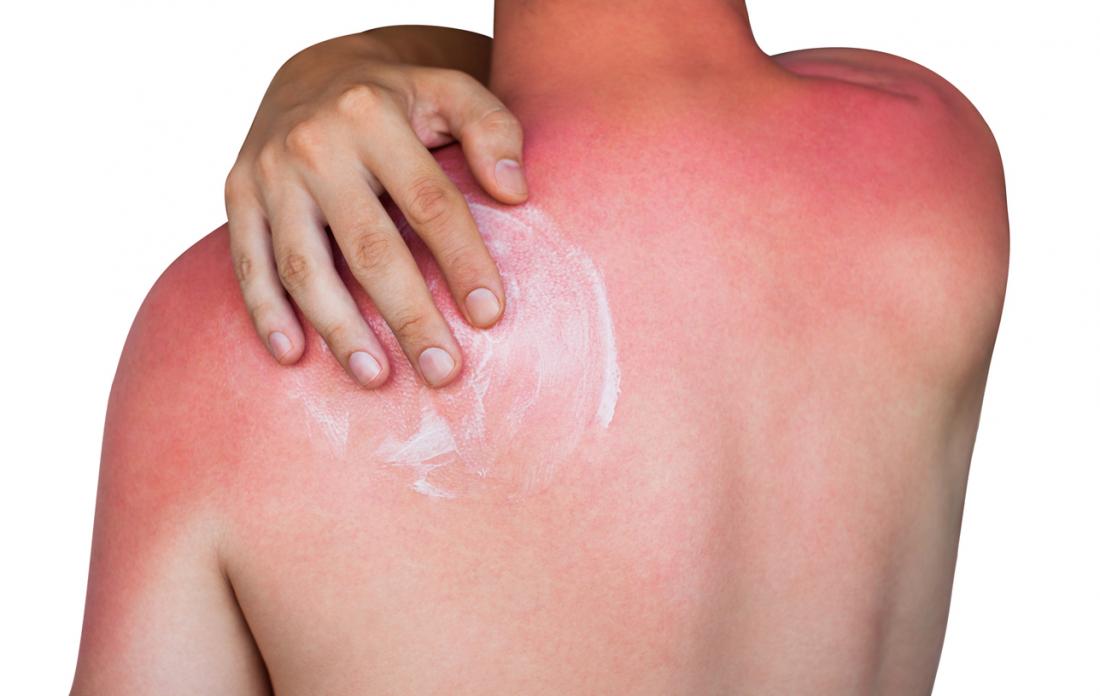Have you considered why color matters for UPF Clothing? Whether it is for yourself or your family, UPF clothing can help protect your skin.

This kind of sunburn can result from sitting in a stadium and watching your favorite team play. Too much sun shining through your shirt will result in sunburn after a while.
Color is important in UPF clothing or anything you wear for your outdoor adventures. If you wore a UPF 30 light-colored shirt and were out too long, you may have been sunburned.
There are limits to how much a garment can protect you after 8 or so hours in the direct sun. Not many people live where the sun shines so directly for 8 or more hours a day. And most people aren’t out in the sun with no breaks or times in the shade.
If you are living where there are many hours of bright sunshine, make sure your UPF shirt is a darker color. There are many factors in getting the best protection, even from UPF clothing. Color science will help.
This can be you at any time there is bright direct sun, and you are out in that sun. Wearing a UPF shirt that is styled with double yokes, and a deep color would have helped protect from this much sunburn.
Make all these new fabrics and color information work for you. I live in a very sunny part of central Texas. It is important for us to protect our skin from the sun. We didn’t for a long time. The information was not out there, and neither was UPF clothing. Don’t set yourself up for skin cancer as we did.
Does Color Matter?
Yes, color matters a great deal. Color can help keep your skin safer in the sun. Science tells us that colors do affect how much sun is reflected or absorbed.
So absorbing heat in the cooler parts of the world, and in cooler seasons would make a good reason to turn to color for help in clothing choices.
While the finish and weave of the UPF clothing keep your skin safer from the sun, a darker UPF garment will handle the sun longer and better.
I don’t know if you have noticed, but we humans are a fickle lot. We want to be able to wear what we want when we want.
UPF clothing offers a variety of colors, weaves, and weights of clothing to suit what we may think we need at different times.
You may stay cooler in warmer seasons with lighter colors. By having UPF clothing, you are protecting your skin as much as you can while getting out outdoors.
In cooler times, darker deeper colors will help keep you warm while enjoying or working outdoors.
Don’t ignore the slight tan you are getting every day when you are out for a long time in the sun. Hopefully, your UPF clothing will protect you from sunburn. However, the tan is also a sign of damaged skin.
A tan is a result of too long in the sun. Tans aren’t healthy. Dermatologists are finding that tanned skin also is developing skin cancer, including melanoma.
So Color Makes A Difference
Let’s look more at this color stuff.
What is considered a “Warm” color?
According to GoodHouseKeeping.com:
- Red
- Orange
- Yellow and mixtures of these 3 like:
- Gold
- Sienna
- Amber
- Deep Pinks
- Peach
- Scarlet
What is considered a “Cool” color?
What are the cool colors?
- Blue
- Light Purple
- Green and combinations of these three.
- Cobalt Blue
- Emerald Green
- Teal
- Eggplant
- Aqua
We don’t think about color relating to clothes as it does to decorating homes. However, I have found that for me and what I wear in the heat or cold, this is a very reliable source and is well-proven.
Think about how a room with dark paint on the walls seems smaller. None of the light is reflected, it is held.
A white or very light wall reflects light. The principle is the same.
Neutral Colors For Clothes
While we are on this color and how to protect our skin from the sun let’s look at neutrals.
Muted shades that seem to not really reflect the color wheel.
- White
- Black
- Beige
- Brown
- Cream
- Gray
- Taupe
When thinking about how these colors protect your skin from the sun, we go from white to black.
Whiter or lighter colors reflect light and heat. They don’t absorb as black does. However the deep color, as in gray, or brown, the more the color absorbs, not reflects.
Darker grey will absorb more heat and sun.
Pale or whiter grey will reflect heat and sun.
This is also true of the color red. Deeper darker red absorbs the sun’s rays, keeping more of the radiation off your skin.
Black is the deepest color and will in, most garments, absorb more sun. If the fabric is shiny, there may be some reflection, but the sun should not reach your skin unless through the weaving holes of a loosely woven fabric.
With so many underlying conditions, one can understand why wearing a sun blocking shirt of a fabric especially designed for keeping out the sun is so appealing. You are not left to evaluate and wonder.
If the tag says 50% UPF you have 98% of the sun’s rays blocked. 30% UPF means there is a 94% block. That is pretty well protected.
Do You Know How To Use UPF Clothing Properly?
Do you understand how to use UPF Clothing?
UPF Clothing, with manufactured in benefits will help protect your skin from the dangers of the sun. As long as you have it on.
It is important to have properly fitted UPF clothing. To tight a fit, and there will be gaps that allow the sun’s UV rays to get onto your skin.
Too large, and the sun will reach your skin under a loosely fitting collar and leave you with a sunburn stripe around your neck. Maybe even across your upper chest and throat if the shirt was not buttoned at the collar and fell loosely. The shirt can not protect your skin if it is not properly fitted, with your skin covered.
You may need a layer of sunscreen on your arms if the shirt isn’t long-sleeved. Remember to reapply every couple of hours. Long sleeves that are loosely fitted are more comfortable to me that having sunscreen that makes my skin hot, and often greasy feeling.
The consistent coverage of a UPF shirt for the trunk of your body and your arms makes keeping safe easier.
With UPF clothing, you can often choose a lighter color and know that you are protected from the sun. The garments last a good while and protect your skin.
UPF Clothing is a tool for keeping your skin safe. However, when you are going to be outdoors all day, expect to take some extra caution. Your sun hat and sunglasses are the starting point for protecting your skin. Covering your skin with UPF clothing is the next layer of defense, adding sunscreen to your face as well as where the clothes don’t cover.
Take breaks in the shade. Find a tree or take your own shade. Drink plenty of water. Nothing is 100% if you are in the sun all day. Plan to start your outdoor activities earlier or later to avoid the mid-day sun. Live a sun-safe lifestyle
Any Shirt Is Better Than No Shirt When In The Sun
The fabric that the shirt is made of is what makes it a sun blocking shirt. Do you know what to look for? Color can make that fabric even safer.
The Best Fabric For Blocking The Sun
The best fabric for a shirt to protect your skin is:
- Specially manufactured fabrics, UPF fabrics
- Cotton viscose fabrics
- Black or dark blue denim jeans
- Wool garments
- Satin-finished silk of any weight
- Tightly woven Bamboo/Lycra fabric
- Polyacrylonitrile
- 100% polyester
- Shiny polyester blends
- Tightly woven fabrics
- Unbleached cotton (most cotton garments sold are bleached cotton)]
- Bamboo/cotton blend
- Densely woven fabric
- Denim is a densely woven fabric.
- Canvas cloth, also is densely or tightly woven.
- Wool or synthetic fabrics or a blend of cotton and synthetic fibers are also more protective.
While the fabric list of fabric above can keep out the sun, some may not be so comfortable to wear when you are in the bright sun. I know for sure that my long sleeve denim is pretty toasty when worn outside in our warm and humid summers, as well as in spring and fall.
But by the same rules, my denim made of synthetic fabric is so thin, and non-breathing that it is cold in winter, and sweaty in the warmer months. So I wear it more in the winter, over a tee shirt. Makes a great, comfortable sun blocking shirt for cooler times in the sun.
This shirt works as a windbreaker as well during times of windy weather.
When I select a lighter-weight fabric, it may be a washed many times tee shirt that is pretty thin. But feels so cool and soft. When this happens, I am setting myself up for an issue with too much sun. Covering with a lightweight sun-blocking shirt is important. Some shirts are made of wicking breathing fabric. I just don’t have one yet.
Examples Of Less Protective Fabrics
Fabrics that are less protective often include:
- Thin or sheer fabric.
- Loosely woven cloth
- Polyester crepe
- Bleached cotton
- Viscose
- Knits
- Undyed/white jeans
- Worn/old fabric
Old fabric is often our choice for outdoor chores. My old tee shirts, old jeans. Jeans will allow sunburn on your legs if the fabric is old. The old fabric has most times lost the ability to fully protect your skin from the sun. There are then places that will allow the sun to shine through to your skin.
Your worn tee shirts, lose the ability for much protection. Thick new ones are better for being out in the sun if you don’t have UPF-rated clothing.
Remember, anything on your body between you and the sun is better than hours of direct sun on your body, regardless of the season of the year.

Sami’s Take On Why Color Matters For UPF Clothing
For someone like me, who has raised a family with no knowledge of the dangers the sun was doing to our skin, UPF clothing is a no-brainer.
For what you have in your closet already, a good Rit Color Guard is a great option. This is especially good for families who may pass down outgrown clothing. Or if you have a chance to take a vacation and haven’t outfitted your whole family in UPF clothing yet.
Adapting a sun-safe lifestyle will insure less skin cancer for your family. Just as science has found that a diet of so much fried meat and cream gravy was not all that healthy, we are finding that too much sun on our skin isn’t healthy either.
Covering your skin while you are in the sun is easy to do. Help your family have safe skin habits. Live a life free of skin cancer.
Do you have some skin protections that are working for you? Do you have some color suggestions? Please help us all keep our skin safer by posting your suggestions or questions here.
Thanks,
Sami